Reading Comprehension Text and Exercises
The World's Most Beautiful Natural Wonders
Throughout its long history, our planet Earth has created many mountains, rivers, volcanos, forests and other beautiful natural places. Some of them are considered to be really special due to their beauty, incredible stories about their creation, and all the living organisms which inhabit them. For these reasons, they are often referred to as the natural wonders of the world, deserving admiration and respect from everyone.
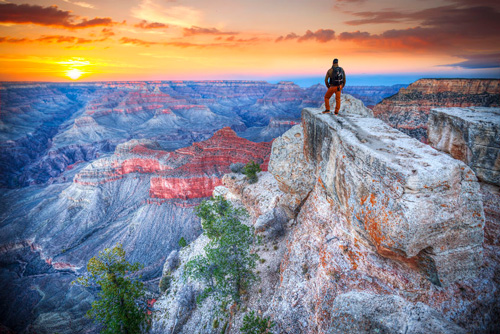
Click Here for Step-by-Step Rules, Stories and Exercises to Practice All English Tenses
Auroras (Northern and Southern Lights)
Imagine seeing the night sky turn bright green, purple and red, and that all of these lights suddenly start dancing around. It is one of most beautiful sights known to humans.
Although these lights, called auroras, look absolutely magical, their occurrence can actually be explained through science. Appearing above the North and South poles, they are created when electrically charged particles from the sun collide and penetrate into the atmosphere.
Their color variations depend on the type of gas particles which come together. Auroras do not just appear every night – their activity happens in cycles, and reaches its peak every 11 years. For this reason, interested observers should really plan their trip carefully.
Apart from the poles, auroras are best seen in parts of Canada, Iceland, Norway and the coastal waters of Siberia.
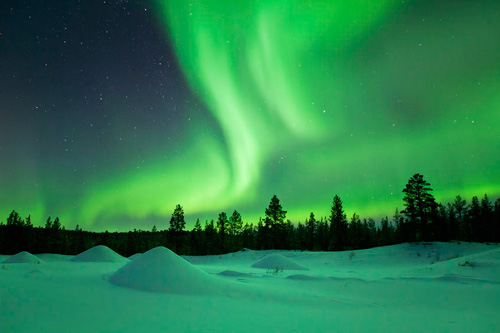
Mount Everest, Nepal
Located in the subrange of the Himalayas, Mount Everest is the world's highest mountain, standing at 29,029 feet (8,848 meters). The Himalayas mountain chain was formed when the Indian tectonic plate, or in other words massive rocks, pushed against the Asian plate.
British mountaineers tried to ascent to the summit of Mount Everest eight times before two of them finally succeeded in 1953. Several thousands of people have climbed to the peak since then, normally with the assistance of Sherpas, local Nepalese people who carry the equipment and know the mountain very well.
Because of the harsh climate and the temperature that can drop down to -76°F (-60°C), this is a very dangerous journey. The mountain is so high that the climbers have to use bottled oxygen to keep their lungs functioning. Interestingly, the summit point also lies on the international border between Tibet and Nepal.
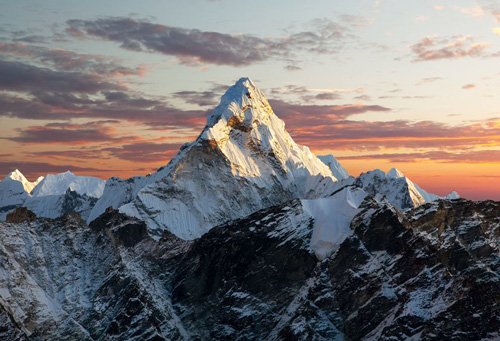
Grand Canyon, the United States of America
This 227 mile (446 km) long canyon is located in the state of Arizona and was carved by the Colorado River. The Grand Canyon reaches the depth of over one mile (1,857 meters). It expands over a vast area which was once inhabited by Native Americans, and was considered to be a holy site.
Scientists believe the Colorado River built this natural wonder up to 6 million years ago. Even though the elevation change from the river to the highest point in the canyon is huge, there are still quite a few plants and animals living there, although most of the animals are rodents (mice and rats) and bat species.
Today, the Grand Canyon is a national park, and tourists can enjoy climbing the beautiful red rocks, rafting on the river, or simply sightseeing.
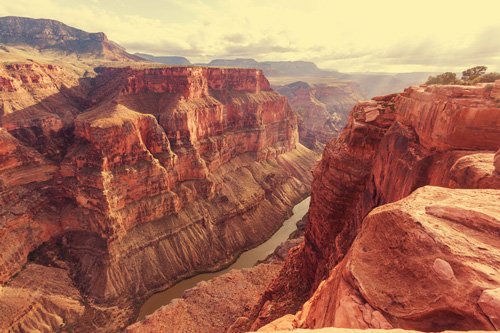
Victoria Falls, Zimbabwe/Zambia
Victoria Falls, or "The Smoke that Thunders" (Mosi-oa-Tunya in the Tonga language), as the locals call it, is a large waterfall on the Zambezi River, bordering Zambia and Zimbabwe.
The world famous explorer David Livingstone is thought be the first European who found the waterfall, naming it in honor of Queen Victoria.
Victoria Falls is considered to be the world's largest waterfall based on the amount of falling water – every second, some 33,000 cubic feet (935 cubic meters) of water fall over. Still water levels are not constant, and they particularly rise during the flood season from February to May.
Victoria Falls is surrounded by a rainforest where it actually rains every single day due to all the vapor rising from the waterfall. Wildlife is abundant in this forest, so it is common to spot an elephant, a zebra, or even a lion in the areas around the waterfall.
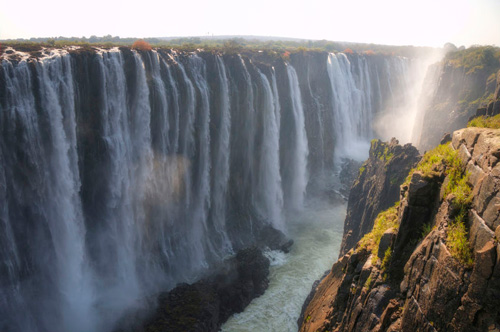
Great Barrier Reef, Australia
Consisting of over 2,900 individual reefs and 900 islands, this is the largest coral reef in the world, spreading across 133,000 square miles (344,400 km2). Being larger than many countries, the Great Barrier Reef is visible from outer space.
The variety of living organisms which make the reef their home is impressive. Over 1500 different species of fish, and a great number of turtles, sharks and seahorses can regularly be seen in the reef. Thirty different species of whales and dolphins also swim in these waters.
While the climate change greatly affects the biodiversity in the reef, most parts of it are protected from fishing. Thousands of tourists who come in every day are also asked to be careful about how they treat this precious environment.
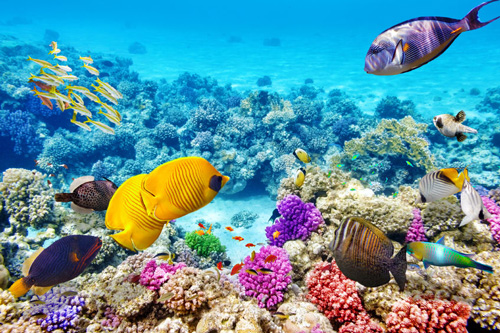
Comprehension Exercises
Vocabulary Questions
- What does "abundant" mean?
- left behind
- rare
- plentiful
- What does "vapor" mean?
- earth mineral
- substance suspended in the air
- melted snow
- What does "collide" mean?
- avoid one another
- grow out of something
- strike one another, crash
- What does "tomb" mean?
- the highest point of a mountain
- the lowest temperature on a mountain
- a base camp on a mountain
- What does "ascent" mean?
- slide down
- gradually become stronger
- climb, move upwards
Collocation Questions
- In the Grand Canyon, the __________ change is huge.
- level
- height
- elevation
- Great Barrier Reef is visible from __________ space.
- exterior
- external
- outer
- Electrically __________ particles create auroras.
- charged
- filled
- powered
- British mountaineers were the first to __________ to the summit.
- rise
- ascent
- take off
- The __________ climate makes climbing Mount Everest very dangerous.
- cruel
- harsh
- grinding
- Australians fear climate __________ will damage the reef.
- change
- distortion
- alteration
- Water levels rise during the __________ season.
- overflowing
- swamping
- flood
- On Mount Everest, the temperature can drop __________ to -76°F.
- low
- down
- close
- It is common to __________ a zebra near Victoria Falls.
- glance
- identify
- spot
- The Grand Canyon was __________ by the Colorado River.
- carved
- designed
- cut up
Wh Questions
- Which river created the Grand Canyon?
- Zambezi
- Colorado
- Grand Yellow
- What does the color of an aurora depend on?
- the time of the year
- the place where it happens
- the type of gas particles
- Why do most mountaineers hire Sherpas?
- to carry the equipment
- to find oxygen
- to communicate with local people
- Where does climate change have a negative impact on biodiversity?
- in the Grand Canyon
- in the Great Barrier Reef
- in the Victoria Falls rainforest
- Who named Victoria Falls?
- Queen Victoria
- the people of Zimbabwe
- David Livingston
Evaluating Statements
- Based on the information in this lesson, which statement is true?
- The Grand Canyon is mostly home to mice, rats and bats.
- Only snakes and lizards can survive in the Grand Canyon.
- Based on the information in this lesson, which statement is false?
- On Mount Everest, mountaineers use bottled oxygen only in rare circumstances.
- It is nearly impossible to climb Mount Everest without additional oxygen.
True or False?
- Based on the information in this lesson, is the following statement true or false?
"It would be possible for astronauts to see the Great Barrier Reef from space." - True
- False
- Based on the information in this lesson, is the following statement true or false?
"The only way to see auroras is to travel to the North Pole." - True
- False
Answer Key
1. C | 2. B | 3. C | 4. A | 5. C | 6. C | 7. C | 8. A | 9. B | 10. B | 11. A | 12. C | 13. B | 14. C | 15. A | 16. B | 17. C | 18. A | 19. B | 20. C |21. A | 22. A | 23. A | 24. B
Get Updates, Special Offers, and English Resources
Download your FREE GIFT (the first two chapters of
English Short Stories Book and Workbook)
as soon as you join!

By submitting your email, you consent to receiving updates and newsletters from us and to the sharing of your personal data with third parties for the purposes of sending you communications. We will not spam you. You can unsubscribe at any time. For more information, please see our privacy policy.





